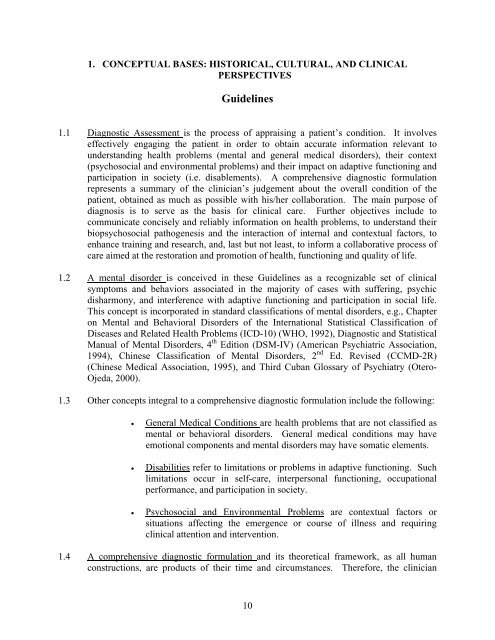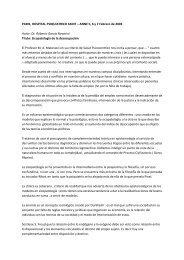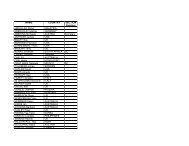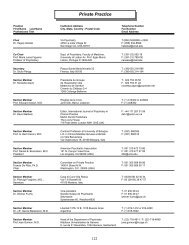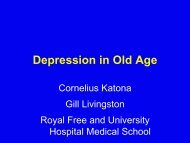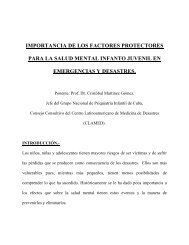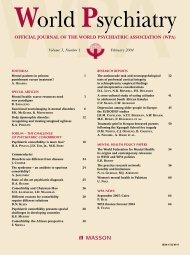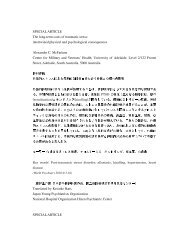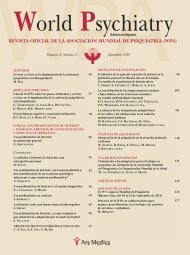Chapters 1-4 - World Psychiatric Association
Chapters 1-4 - World Psychiatric Association
Chapters 1-4 - World Psychiatric Association
Create successful ePaper yourself
Turn your PDF publications into a flip-book with our unique Google optimized e-Paper software.
1. CONCEPTUAL BASES: HISTORICAL, CULTURAL, AND CLINICALPERSPECTIVESGuidelines1.1 Diagnostic Assessment is the process of appraising a patient’s condition. It involveseffectively engaging the patient in order to obtain accurate information relevant tounderstanding health problems (mental and general medical disorders), their context(psychosocial and environmental problems) and their impact on adaptive functioning andparticipation in society (i.e. disablements). A comprehensive diagnostic formulationrepresents a summary of the clinician’s judgement about the overall condition of thepatient, obtained as much as possible with his/her collaboration. The main purpose ofdiagnosis is to serve as the basis for clinical care. Further objectives include tocommunicate concisely and reliably information on health problems, to understand theirbiopsychosocial pathogenesis and the interaction of internal and contextual factors, toenhance training and research, and, last but not least, to inform a collaborative process ofcare aimed at the restoration and promotion of health, functioning and quality of life.1.2 A mental disorder is conceived in these Guidelines as a recognizable set of clinicalsymptoms and behaviors associated in the majority of cases with suffering, psychicdisharmony, and interference with adaptive functioning and participation in social life.This concept is incorporated in standard classifications of mental disorders, e.g., Chapteron Mental and Behavioral Disorders of the International Statistical Classification ofDiseases and Related Health Problems (ICD-10) (WHO, 1992), Diagnostic and StatisticalManual of Mental Disorders, 4 th Edition (DSM-IV) (American <strong>Psychiatric</strong> <strong>Association</strong>,1994), Chinese Classification of Mental Disorders, 2 nd Ed. Revised (CCMD-2R)(Chinese Medical <strong>Association</strong>, 1995), and Third Cuban Glossary of Psychiatry (Otero-Ojeda, 2000).1.3 Other concepts integral to a comprehensive diagnostic formulation include the following:• General Medical Conditions are health problems that are not classified asmental or behavioral disorders. General medical conditions may haveemotional components and mental disorders may have somatic elements.• Disabilities refer to limitations or problems in adaptive functioning. Suchlimitations occur in self-care, interpersonal functioning, occupationalperformance, and participation in society.• Psychosocial and Environmental Problems are contextual factors orsituations affecting the emergence or course of illness and requiringclinical attention and intervention.1.4 A comprehensive diagnostic formulation and its theoretical framework, as all humanconstructions, are products of their time and circumstances. Therefore, the clinician10
should be aware that they reflect historical developments, cultural factors, ethical norms,and clinical and epidemiological requirements at a particular point in time.1.5 The psychiatric interview is the single most important part of the diagnostic evaluationprocess. It affords the means to establish rapport and to elucidate clinical data bylistening to and probing the patient and observing his/her behavior. The interview is themain source of information on the course of the condition, the personality of the patient,his or her biography, adaptive functioning and environmental and psychosocial stressors.It is also the basis of the idiographic (personalized) evaluation of the patient. Theinterview is conducted according to professionally accepted rules and ethical standards,and requires appropriate training.1.6 The clinician must consider other sources of information, besides the clinical interview.This is essential in special circumstances that prevent the patient from providinginformation. Records of previous hospitalizations and outpatient treatment are usuallyimportant to consult. Other sources, e.g., relatives, friends, neighbors, police, should beconsulted, whenever appropriate, with the patient’s consent and assuring confidentialityin their use.1.7 All patients presenting for psychiatric care should receive a comprehensive evaluation ofsymptoms and mental status. A basic physical evaluation is advisable, which, whennecessary, should include a physical examination. All psychopathological terms shouldbe used in a reliable and comparable way, and all areas of psychopathology should bedescribed in a systematic and standardized manner. Supplementary assessmentprocedures are further sources of information, which range from specialized physicalevaluation, laboratory tests and imaging procedures to structured or standardizedinstruments for the assessment of the clinical condition. The clinician should be familiarwith them and with the prerequisites for their use.1.8 The diagnostic process involves more than identifying a disorder. Positive aspects ofhealth, such as personal and social assets and quality of life, should also be described.Concerning the presentation of diagnosis, a nomothetic or standardized diagnosticformulation (e.g. ICD-10, DSM-IV) is to be combined with an idiographic orpersonalized diagnostic formulation, reflecting the individuality and uniqueness of thepatient’s personal experience. At the nomothetic level, a multiaxial diagnosticformulation is recommended. For the idiographic formulation, an integration of theperspectives of the clinician, patient and family should be presented in natural language.1.9 The main objective of diagnosis is patient care. A care plan should be prepared on thebasis of both the multiaxial formulation of the patient’s condition (taking into accountclinical disorders present, disablements, contextual factors, and quality of life) as well asthe idiographic diagnostic formulation (e.g., patient’s needs and expectations, culturalfactors and economic and therapeutic resources). The program of care should includeadditional diagnostic studies and specific therapeutic interventions. Evolvinglongitudinal observations should lead to periodic updating of the comprehensivediagnostic formulation.11
1.10 A record of information documenting the comprehensive diagnostic assessment should bekept in every individual patient’s chart. This information should be presented in anorganized format that includes narrative components.12
Recommended Readings:(Section 1)Barron, J.W. (Ed.) (1998): Making diagnosis meaningful. Washington, DC: AmericanPsychological <strong>Association</strong>.Mezzich, J. E., Kleinman, A., Fabrega, H., Parron, D. L. (Eds.) (1996). Culture and psychiatricdiagnosis: A DSM-IV perspective. Washington, D. C.: American <strong>Psychiatric</strong> Press.Misés, R., Fortineau, J., Jeammet, P., Lang, J.-L., Mazet, P., Plantade, A., Quémada, N. (1988):Classification Francais des Troubles Mentaux de L’Enfant et de L’Adolescent (FrenchClassification of Mental Disorders of Children and Adolescents). Psychiatrie de L’Enfant,31, 61-134.Zadler, J. Z., Wiggins, O. P., Schwartz, M. A. (1994). Philosophical perspectives on psychiatricdiagnostic classification. Baltimore: Johns Hopkins University Press.Zheng, Y. P., Lin, K-M, Zhao, J. P., Zhang, M. Y., Young, D. (1994). Comparative study ofdiagnostic systems: Chinese Classification of Mental Disorders, 2 nd ed. Versus DSM-III-R.Comprehensive Psychiatry, 35, 441-449.13
Figure 1: A Diagrammatic View of Comprehensive Diagnostic Assessment (Section 1)Patient InterviewExtended SourcesofInformationSupplementalAdditionalProceduresA. History• Present Illness• Family• Developmental• Social• General MedicalB. SymptomEvaluation• Past Records• Family• Friends• Past Therapists• Referring Sources• Consultants• Phenomenological• Psychological• General Medical• Functioning• Socio-Cultural• Quality of LifeComprehensive Diagnostic Formulation1. Standardized Multiaxial Formulation2. Personalized Idiographic FormulationComprehensive Treatment Planning14
2. INTERVIEWING THE PATIENTGuidelines2.1 An appropriate setting for the psychiatric interview should be selected or arranged withinthe circumstances available. It should optimize comfort of the patient and theinterviewer, protect privacy and minimize external distractions.2.2 The clinician should establish trusting rapport with the person by introducing him/herself,greeting the person appropriately, explaining the purpose of the interview, ensuringconfidentiality to the extent possible, and communicating an intention to be of help.2.3 The interview is a dynamic process, involving a clinician and patient, that should lead tomutual understanding, without blurring their respective roles. The clinician should adoptan attentive, interested, listening attitude, convey respect for the person’s wishes anddignity, strive to create a naturalistic and conversational flow, and facilitate theengagement of the patient in the interview.2.4 Cultural considerations should inform the conduct of the interview. The clinician andpatient should discuss cultural issues and opportunities and language barriers and agreeon ways to deal with them. Whenever necessary, competent and thoughtful translatorsand cultural consultants (without undermining clinician-patient engagement) should beutilized.2.5 The clinician should explore the circumstances leading to the patient’s presentation forevaluation and his/her expectations for care. Gaining an understanding of the patient’slife history and concerns for quality of life is also important. An effort should be made toencourage the patient to express himself or herself in the way he/she would like to beheard.2.6 Through anamnesis, information should be systematically gathered on the major mentalhealth problems of the patient, including timeframe, mode and circumstances of onset,clinical signs and symptoms, dangerous behaviors, concomitant functional difficulties,relevant contextual factors, illness course, treatment received, and efforts at restoration ofhealth and quality of life (from physical well-being to spirituality).2.7 The clinician should obtain systematic information on other important aspects of thepatient’s clinical background, including family, developmental, social, occupational,substance use, and general medical histories.2.8 The clinician should endeavor to maintain a collaborative rapport with the patient leadingto the formulation of a jointly agreed care plan.2.9 On approaching the end of the interview, the next steps for diagnostic and therapeuticefforts should be specified. Further diagnostic efforts may include, as appropriate, and15
with the patient’s consent to the fullest possible extent, interviewing family members andother individuals knowledgeable about the patient’s condition, as well as usingsupplementary assessment instruments and procedures.2.10 The clinician should work with the patient towards closing the interview in a manner thatpromotes in the patient greater self-esteem, a sense of hope, cooperation and clarity ongoals, expected progress and the process to follow.16
Recommended Readings(Section 2)Anderson, A. K., Lynch, T. (1996). Listening. Oxford, U. K.: Oxford University Press.Deniker, P., Féline, A. (1990). Le premier contact et l’observation in psychiatrie (The firstcontact and observation in psychiatry). In P. Deniker, T. Lempériere & J. Guyotat (Eds.).Précis de psychiatrie clínique de l’adulte. (pp. 5-11). Paris: Masson.Barcia-Salorio, D., Muñoz-Pérez, R. (1991). The interview in psychiatry. In A. Seva (Ed.). TheEuropean handbook of psychiatry and mental health. (pp. 443-458). Zaragoza: PrensasUniversitarias de Zaragoza.Shea, S. C. (1998). <strong>Psychiatric</strong> interviewing: The art of understanding, 2 nd Edition. Philadelphia:W. B. Saunders.Ward, N. G., Stein, G. (1975). Reducing emotional distance: A new method of teachinginterviewing skills. Journal of Medical Education, 50, 605-614.17
Figure 2: Interviewing Process (Section 2)OPENING• Setting• RapportBODY• Anamnesis• Examination• Understanding• PlanningCLOSURE• Sense of Hope• Next Steps18
3. USE OF EXTENDED SOURCES OF INFORMATION: LIVE ANDDOCUMENTARYGuidelines3.1 The use of extended sources of information is an important part of the diagnostic process,since they corroborate, complement or correct information provided by the patienthim/herself.3.2 Sources of information relevant to the diagnostic enterprise should be selected based onthe specific objectives of the evaluation and the particular setting where the assessment istaking place (school, emergency room, police station, detention center, etc). In mostcases, the minimal standards on extended sources of information may be to consult therecords of any previous treatments and to contact one relevant person.3.3 The use of extended sources becomes even more essential in special circumstances thatprevent the patient from providing adequate information; e.g., at the emergency room,when the patient is too young or too old, or when the patient is in a psychotic state,intoxicated or unconscious.3.4 Specific types of data collected through extended sources of information vary accordingto the type of patient and his/her special circumstances. Developmental history, familyhistory, diagnoses made during previous hospitalizations, and current functioning areexamples of data that frequently the patient is not able to provide fully and require the useof extended sources of information.3.5 The need to use other sources of information should be discussed with the patient andhis/her consent should be requested whenever possible and in accordance to culturalnorms. Specific thoughts and feelings the patient may have about these sources shouldbe explored. The patient should be assured of confidentiality to the fullest extentpossible. This may be especially critical in circumstances where revealing a family secretmay have serious consequences for the patient’s relationship with his/her primary supportgroup. Whenever confidentiality on the part of the clinician requires to be limited, thisshould be made explicit.3.6 If the patient is a young child, the clinician should interview the parents, other caretakers,teachers, camp counselors, school psychologists, pediatricians, other relatives, and allthose who can provide information about the current behavior and functioning of thechild, and his/ her psychosocial functioning and adaptation.3.7 Information provided by other sources should be treated with the same thoughtful andcritical attitude used for information provided by the patient. One must remember thatinformation offered by other sources is not the ultimate truth about the condition of thepatient, but a different perspective, and it might be in fact another source of unreliability.19
Clinical judgment and experience should be displayed to sort out sources of unreliability,and to adequately weigh the diagnostic value of all collected data.3.8 Confidentiality should be assured to the person giving information, to the fullest extentpermissible by law and local customs. One must be aware that he/she could be involvedin a conflictual relationship with the patient.3.9 The patient’s records, the records of relatives, as well as judicial, social, counseling andeducational records are all examples of useful documentary sources of information.Usually consent by the patient is necessary to consult these sources.3.10 Past records may be helpful but they should be reviewed with a critical attitude. Forexample, when using old records one must be attentive to diagnostic practices prevalentat the time when such records were prepared. For instance, cases of bipolar disorder orborderline personality could have erroneously been diagnosed before as schizophrenia.20
Recommended Readings(Section 3)Bird, H. R., Gould, M. S., Staghezza, B. (1992). Aggregating data from multiple informants inchild psychiatry. Journal of the American Academy of Child & Adolescent Psychiatry, 31,78-85.Herjanic, B., Herjanic, M., Brown, F., Wheatt, T. (1975). Are children reliable reporters? Journalof Abnormal Child Psychology, 3, 41-48.Lavretsky, E. P., Jarvik L. F. (2000). <strong>Psychiatric</strong> examination of the older patient. In B. J. Sadock& V. A. Sadock (Eds.) Kaplan & Sadock’s Comprehensive textbook of psychiatry. 7th ed.Vol. 2. (pp. 2998-3010). Baltimore: Williams & Wilkins.Reich, W., Earls, F. (1987). Rules for making psychiatric diagnosis in children on the basis ofmultiple sources of information: Preliminary strategies. Journal of Abnormal ChildPsychology, 15, 601-616.Rotondo, H. (1998): Orientaciones al estudiante para la historia clínica psiquiátrica (Guidelinesfor students on the psychiatric clinical history). In A. Perales, A. Mendoza, G. Vásquez-Caicedo, M. Zambrano (Eds.) Manual de Psiquiatría “Humberto Rotondo”, 2 nd Edición.Lima, Peru: Editorial de la Universidad Nacional Mayor de San Marcos.21
Figure 3: Use of Extended Sources of Information (Section 3)RelativesFriendsPastTherapistsTeachersPastRecordsCounselorsSocialAgents22
4. EVALUATION OF SYMPTOMS AND MENTAL STATUSGuidelines4.1 All patients presenting for psychiatric care should receive a comprehensive descriptivepsychopathological evaluation. This should include a broad symptomatologicalassessment specifying the time frames of the findings, as well as a mental statusexamination at the time of the patient interview.4.2 Five major areas of psychological functioning and psychopathology should be evaluated:• Consciousness, orientation, memory, and intellect.• Speech, thinking, perception, and self-experience• Emotions• Physical signs and symptoms of mental disorder• Behavior and adaptive functioning4.3 Standardized definitions of terms should be used in describing the elements ofpsychopathology. Standardized glossaries should be consulted, such as the WHO (1994)Lexicon of <strong>Psychiatric</strong> and Mental Health Terms and the Schedules for ClinicalAssessment in Neuropsychiatry (WHO, 1999).4.4 A comprehensive evaluation documents symptoms elicited or observed during theinterview, those present in the recent past and relevant to the current illness, as well asthose present during the more distant past and relevant to the past psychiatric history.4.5 The assessment of signs and symptoms requires careful observation of the patient duringthe interview, listening to the patient’s narrative as he/she presents a chief complaint andhistory, and specific questioning in suspected problem areas. Evidence of signs andsymptoms may also come from ancillary information sources, such as records of priortreatment and reports of relatives, friends, representatives of social agencies, and otherprofessionals.4.6 The clinical significance of symptoms should be determined by a consideration of theirseverity. Severity is reflected in the intensity, frequency, and duration of symptoms, theirtendency to cause subjective distress, and their impact on the patient’s functioning.Symptom severity should be documented. Violent and suicidal ideation and behaviorsshould be pointedly assessed and documented.4.7 The evaluation of symptoms should be guided by hypotheses about their diagnostic orsyndromic significance. Observations and lines of questioning should be based on theidentification of major psychiatric syndromes and ruling out specific disorders indifferential diagnosis.23
4.8 Variations in the presentation of psychopathology according to a patient’s age, gender,and sociocultural background should be considered in the conduct of the examination andin the interpretation of collected information, e.g., depression tends to presentpredominantly with somatic symptoms in traditional societies. The significance of anybehavior or mentation, as indicative of psychopathology or as culturally sanctioned,should be carefully considered.4.9 The findings of the mental status exam should be summarized according to standarddomains, such as the following:• Sensorium• Memory• Judgment• Insight• Speech and thought processes• Thought content• Perception• Mood and affect• Appearance• Overt Behavior4.10 Attention should be paid to diagnostic criteria (such as those of ICD-10 and DSM-IV) toguide the evaluation of symptoms and mental status and to appraise the significance oftheir syndromic significance. However, the possibility of cultural and regional variationsand of atypical presentations should be considered.References (Section 4)<strong>World</strong> Health Organization (1994). Lexicon of psychiatric and mental health terms. 2 nd Edition.Geneva: WHO.<strong>World</strong> Health Organization (1999). Schedules for Clinical Assessment in Neuropsychiatry(SCAN). Geneva: WHO.24
Recommended Readings(Section 4)Delgado H. (1993). Curso de Psiquiatría (Course in Psychiatry). Lima, Peru: Fondo Editorial dela Universidad Peruana Cayetano Heredia.Jaspers, K. (1973). Allgemeine Psychopathologie (General Psychopathologie). 9 Auflage. Berlin:SpringerLopez-Ibor, J. J., Ortiz Alonso, T., Lopez-Ibor Alcocer M. I. (1999). Lecciones de PsicologíaMédica (Lessons in Medical Psychology). Barcelona: Masson.Sims, A. (1995). Symptoms in the mind: An introduction to descriptive psychopathology. 2 ndEdition. London: W. B. Saunders.Skodol, A. E., Shaffer D., Gurland, B. (1997). Psychopathology across the life cycle. In A.Tasman, J. Kay, J. A. Lieberman (Eds.) Psychiatry. (pp. 449-476). Philadelphia: W. B.Saunders.25
Table 1: Evaluation of Symptoms and Mental Status (Section 4)Broad Symptomatological Areas(Anamnesis)Major Sections of Mental Status(Examination)• Consciousness, orientation, memoryand intellect(e.g. decreased intellectualfunctioning)- Sensorium(e.g. inattentiveness)- Memory(e.g. decreased recall)- Judgment(e.g. gross opinionatedness)- Insight(e.g. unawareness of illness)• Speech, thinking, perception andself-experience(e.g. persistent delusions,depersonalization)• Emotions(e.g. sadness)- Speech and thought processes(e.g. loose associations)- Thought content(e.g. bizarre ideas)- Perception(e.g. hallucinations)- Mood and affect(e.g. crying)• Physical manifestations of mentaldisorder(e.g. sleep or weight changes)- Appearance(e.g. self-neglect)• Behavior and adaptive functioning(e.g. callousness, intentionalineffectiveness)- Overt behavior(e.g. agitation)26


